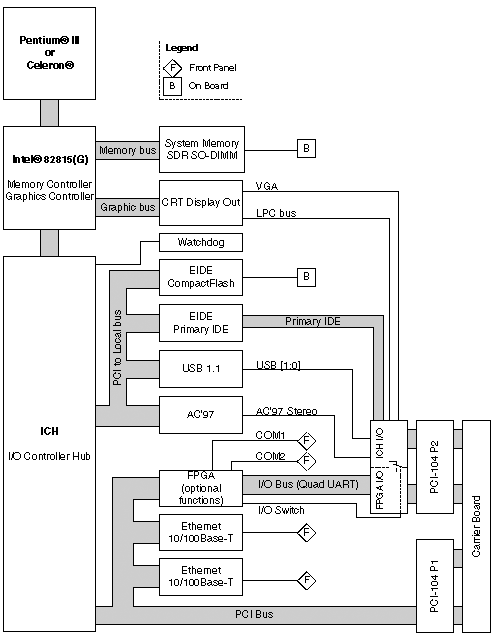Product Description |
|
The EM07 is a complete embedded single-board
computer for use on any carrier board in different industrial environments.
The final application consists either of a stand-alone EM07, the EM07 with
an application-specific carrier card and/or with additionally plugged
PCI-104 modules. |
|
Technical Data |
|
CPU |
Celeron® or Pentium® III 400MHz or 650MHz or 933MHz
processor core frequency 256KB or 512KB L2 cache 100MHz or 133MHz system bus
frequency 33MHz APIC bus frequency |
|
Graphics |
Integrated VGA graphics controller |
|
Memory |
512MB SDRAM CompactFlash interface |
|
Interfaces |
10/100Base-T PCI Ethernet
controller Two USB 1.1 interfaces AC'97 audio |
|
Mass Storage |
Fast IDE ports |
|
Additional I/O through FPGA |
Available at I/O connector Depending on FPGA composition COM 1 and 2 at the front via RJ45
(or 9-pin D-Sub) connector |
|
PCI Interface |
32-bit PCI interface at PCI-104
connector J1 |
|
Miscellaneous |
Real-time clock, backed up by the
carrier board Integrated hardware monitor |
|
Electrical Specifications |
Supply voltage/power consumption: MTBF: 100,000h @ 50°C |
|
Mechanical Specifications |
Dimensions: conforming to ESM
specification (PCB: 149mm x 71mm) Weight: tbd. (incl. heat sink) |
|
Environmental Specifications |
Temperature range (operation): Temperature range (storage):
-40..+85°C Relative humidity (operation):
max. 95% non-condensing Relative humidity (storage): max.
95% non-condensing Altitude: -300m to + 3,000m Shock: 15g/11ms Bump: 10g/16ms Vibration (sinusoidal):
2g/10..150Hz |
|
Safety |
PCB manufactured with a
flammability rating of 94V-0 by UL recognized manufacturers |
|
EMC |
Tested according to EN 55022 /
1999-05 (radio disturbance) and EN 55024 / 1999-05 (immunity) with regard to
CE conformity |
|
Software Support |
Award BIOS Windows (on request) Linux (on request) VxWorks (on request) QNX (on request) RTX (on request) |
Diagram |

Related Products & Downloads |
|
Standard Hardware |
|
|
|
F11, 3U 3-slot 32-bit/33MHz CompactPCI system slot SBC with ULV Pentium® III Celeron® 650MHz, 512MB SDRAM, 2MB SRAM, CompactFlash slot, 2.5" hard disk slot, dual Fast Ethernet (RJ45 front), COM 1 (D-Sub front), dual USB 1.1 (front), keyboard/mouse (front), VGA graphics controller, up to 1600 x 1200 pixels, standard FPGA content: dual UART, SRAM, GPIO; operation temperature 0..+60°C |
|
Please refer to our ESM - Embedded System Modules compare
chart for a selection of further single-board computers with different
processors and on-board functionality. |
|
|
FPGA IP Cores |
|
|
This MEN board offers the possibility to add customized I/O functionality in FPGA. Every standard board comes with a preconfigured FPGA configuration. For additional functions already developed by MEN please refer to our FPGA IP Core overview. More IP cores that can be used in combination with MEN IP
cores are available for example from
www.altera.com or
www.opencores.org. |
|
|
Altera offers free download of its FPGA development software:
The Quartus II Web Edition software includes a complete environment for FPGA
and CPLD design, including schematic- and text-based design entry,
integrated VHDL and Verilog HDL synthesis and support for third-party
synthesis software, SOPC Builder system generation software,
place-and-route, verification, and programming. For more information and
free download of the software please refer to
www.altera.com/products. The Altera Tools Selector guide describes the
Altera tool offerings and requirements. The online version of the document
is available at
www.altera.com/literature. |
|
|
Accessories |
|
|
For more functions realized with SA adapters, see the listing on MEN's website. You can also view our SA adapter compare chart for a quick overview of different functions. Please contact sales to make sure that these SA adapters can
be used in the board configuration you are looking for. |
|